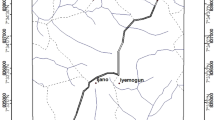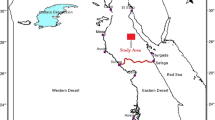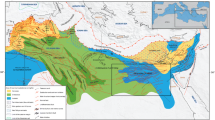Abstract
Aeromagnetic data of the western part of Koraimat-Alzafarana road, Eastern Desert, Egypt is interpreted to detect the subsurface structures that may resulted in presence of subsurface aquifer. To reach to the main target of this study, many procedures are done using some magnetic analysis techniques (e.g., technique of reduction to the magnetic pole, separation technique of regional-residual anomalies and edge detection methods). The results have been encouraging to merit further estimation of the magnetic depth and analyzing the trends of the study area. To increase the credibility, the depth is revised by the P-depth technique. The shallow and deep magnetic components are calculated to be 2046 and 5680 m. To ease the detection of the structure that encasing the study area and lack the rigorous analysis, reduced the magnetic pole map, residual map and 3D Euler deconvolution are integrated to depict the combined lineament map that prevailing tectonic pattern of the study area. Eventually, NE–SW trend is the predominant structural trend affecting on the study area as deducing from magnetic anomalies. Moreover, there are minor structural trends which were taken N–S, NW–SE, W–E, NNW–SSE and NNE–SSW directions. The presence of subsurface structures may assist in the occurrence and recharging of the groundwater aquifers.








Similar content being viewed by others
References
Alhussein Adham Basheer (2016). Implementation of aeromagnetic data analysis at Wadi Zeidun Area, Central Eastern Desert, Egypt. Int J Geol Earth Sci 2(4). http://www.ijges.com. http://new.ijges.com/uploadfile/2020/0303/20200303104613276.pdf (ISSN 2395-647X)
Aero Service (1984). Final operational report of airborne magnetic/radiometric survey in the Eastern Desert, Egypt for the Egyptian General Petroleum Corporation: Aero Service, Houston, Texas, April, six volumes
Affleck J (1963) Magnetic anomaly trend and spacing patterns. Geophysics 28(3):379–395
Alasi TK, Ugwu GZ, Ugwu CM (2017) Estimation of sedimentary thickness using spectral analysis of aeromagnetic data over Abakaliki and Ugep areas of the Lower Benue Trough, Nigeria. Int J Phys Sci 12(21):270–279
Allen RL, Mills D (2004) Signal analysis: time, frequency, scale, and structure. Wiley
Barbosa VCF, Medeiros WE (2001) Scattering, symmetry, and bias analysis of source-position estimates in Euler deconvolution and its practical implications. Geophysics 66(4):1149–1156
Barbosa VC, Silva JB, Medeiros WE (1999) Stability analysis and improvement of structural index estimation in Euler deconvolution. Geophysics 64(1):48–60
Blakely RJ (1995) Potential theory in gravity and magnetic applications. Cambridge University Press
Blakely RJ (1996) Potential theory in gravity and magnetic applications. Cambridge University Press, p 447
CONOCO (1987) Geological map of Egypt, NF 36 NW El Sad El Ali. Scale 1:500000. The Egyptian General Petroleum Corporation GPC and Conoco Co.
Didger (2008) Golden Software; Golden, CO, digitizing software program, Version 3, Shareware software in the category Education developed by Golden Software, Inc.
EROS, U USGS EROS archive—digital elevation—Shuttle Radar Topography Mission (SRTM) 1 Arc-Second Global
Exploration Geophysics (2020) Wikipedia the free encyclopedia. https://en.wikipedia.org/wiki/Exploration_geophysics
Fairhead JD, Salem A, Williams S, Samson E (2008) Magnetic interpretation made easy: the tilt-depth-dip-Δk method. In: SEG technical program expanded abstracts 2008. Society of Exploration Geophysicists, pp 779–783
FitzGerald D, Reid A, McInerney P (2004) New discrimination techniques for Euler deconvolution. Comput Geosci 30:461–469
G Program (Oasis Montaj) (2015) Aero Service Company, Mineral Petroleum Ground- Water Assessment Program (MAGMAP), 2-D frequency-domain processing. Geosoft Inc., Toronto
Geosyntec (2004) Toolkit topics. Connecticut Department of Environmental Conservation Connecticut Stormwater Quality Manual. https://megamanual.geosyntec.com/npsmanual/subsurfacerechargestructures.aspx
Green R, Stanley JM (1975) Application of a Hilbert transform method to the interpretation of surface-vehicle magnetic data. Geophys Prospect 23(1):18–27
Hall DH (1964) Magnetic and tectonic regionalization on Texada Island. BC Geophys 29(4):565–581
Harris E, Jessell M, Barr T (1996) Analysis of the Euler deconvolution technique for calculating regional depth to basement in an area of complex structure. In: SEG Technical Program Expanded Abstracts 1996. Society of Exploration Geophysicists
Hinze WJ, Von Frese RR, Von Frese R, Saad AH (2013) Gravity and magnetic exploration: principles, practices, and applications. Cambridge University Press
Jeng Y, Lee YL, Chen CY, Lin MJ (2003) Integrated signal enhancements in magnetic investigation in archaeology. J Appl Geophys 53(1):31–48
Joshua EO, Layade GO, Adewuyi SO (2018) Analytic signal method (Hilbert solution) for the investigation of iron-ore deposit using aeromagnetic data of Akunnu-Akoko Area, Southwest, Nigeria. Phys Sci Int J 17:1–9
Keating P, Pilkington M (2004) Euler deconvolution of the analytic signal and its application to magnetic interpretation. Geophys Prospect 52(3):165–182
Khalil A, Abdel Hafeez TH, Saleh HS, Mohamed WH (2016) Inferring the subsurface basement depth and the structural trends as deduced from aeromagnetic data at West Beni Suef area, Western Desert, Egypt. NRIAG J Astron Geophys 5(2):380–392
Klingele EE, Marson I, Kahle HG (1991) Automatic interpretation of gravity gradiometric data in two dimensions: vertical gradient 1. Geophys Prospect 39(3):407–434
Lee YW (1960) Statistical theory of communication. Am J Phys 29(4):276–278 (pp 1–75)
Li X (2006) Understanding 3D analytic signal amplitude. Geophysics 71(2):L13–L16
Lin-Ping H, Zhi-Ning G (1998) On: “Magnetic interpretation using the 3-D analytic signal” (Walter R. Roest, Jacob Verhoef, and Mark Pilkington, GEOPHYSICS, 57, 116–125). Geophysics 63(2):667–670
Lisle RJ (2006) Google Earth: a new geological resource. Geol Today 22(1):29–32
MacLeod IN, Jones K, Dai TF (1993) 3-D analytic signal in the interpretation of total magnetic field data at low magnetic latitudes. Explor Geophys 24(4):679–688
Marson I, Klingele EE (1993) Advantages of using the vertical gradient of gravity for 3-D interpretation. Geophysics 58(11):349–355
Megahed AA, Omran MA, Selim EI, Basheer AA (2020) Implementation of magnetic technique to delineate the subsurface tectonic trends of Wadi Barqa surrounding area, southeast of Sinai Peninsula, Egypt. IOSR J Appl Geol Geophys (IOSR-JAGG) 8(5 Ser. I):15–23. https://webcache.googleusercontent.com/search?q=cache:UrEHNKVKfz0J:https://www.iosrjournals.org/iosr-jagg/papers/Vol.%25208%2520Issue%25205/Series-1/B0805011523.pdf+&cd=1&hl=ar&ct=clnk&gl=eg
MHUUD (2015) Environmental characterization of the new city of Beni Suef. https://www.eeaa.gov.eg/portals/0/eeaaReports/NewCitiesProfile/banisuef.pdf
Miller HG, Singh V (1994) Potential field tilt—a new concept for location of potential field sources. J Appl Geophys 32(2–3):213–217
Milligan PR, Gunn PJ (1997) Enhancement and presentation of airborne geophysical data. J Aust Geol Geophys 17(2):63–75
Mosaad S, Kehew AE (2019) Integration of geochemical data to assess the groundwater quality in a carbonate aquifer in the southeast of Beni-Suef city. Egypt. J Afr Earth Sci 158:103558
Mushayandebvu MF, van Driel P, Reid AB, Fairhead JD (2001) Magnetic source parameters of two-dimensional structures using extended Euler deconvolution. Geophysics 66(3):814–823
Mushayandebvu MF, Lesur V, Reid AB, Fairhead JD (2004) Grid Euler deconvolution with constraints for 2D structures. Geophysics 69(2):489–496
Nabighian MN (1972) The analytic signal of two-dimensional magnetic bodies with polygonal cross-section: its properties and use for automated anomaly interpretation. Geophysics 37(3):507–517
Nabighian MN (1974) Additional comments on the analytic signal of two-dimensional magnetic bodies with polygonal cross-section. Geophysics 39(1):85–92
Nwankwo LI (2014) Discussion on spectral analysis of aeromagnetic data for geothermal energy investigation of Ikogosi Warm Spring—Ekiti State, southwestern Nigeria. Geotherm Energy 2:11. https://doi.org/10.1186/s40517-014-0011-3
Reeves C (2005) Aeromagnetic surveys: principles, practice and interpretation, vol 155. Geosoft, Washington (DC)
Reford MS (1962) Magnetic anomalies over thin sheets. Geophysics 29(4):532–536
Reid AB, Allsop JM, Granser H, Millett AT, Somerton IW (1990) Magnetic interpretation in three dimensions using Euler deconvolution. Geophysics 55(1):80–91
Roest WR, Verhoef J, Pilkington M (1992) Magnetic interpretation using the 3-D analytic signal. Geophysics 57(1):116–125
Ruotoistenmaki T (1993) The magnetic anomaly of 3D sources having arbitrary geometry and magnetization. Geophys Prospect 41(4):413–433
Saber SG, Salama YF (2017) Facies analysis and sequence stratigraphy of the Eocene successions, east Beni Suef area, eastern Desert. Egypt J Afr Earth Sci 135:173–185
Said R (1962) The geology of Egypt. Elsevier Publ. Co., Amestrdam
Salem A, Ravat D (2003) A combined analytic signal and Euler method (AN-EUL) for automatic interpretation of magnetic data. Geophysics 68(6):1952–1961
Salem A, Ushijima K, Elsirafi A, Mizunaga H (2000) Spectral analysis of aeromagnetic data for geothermal reconnaissance of Quseir area, northern Red Sea, Egypt. In: Proceedings of the world geothermal congress, vol 16691674
Salem A, Ravat D, Gamey TJ, Ushijima K (2002) Analytic signal approach and its applicability in environmental magnetic investigations. J Appl Geophys 49(4):231–244
Salem A, Williams S, Fairhead JD, Ravat D, Smith R (2007) Tilt-depth method: a simple depth estimation method using first-order magnetic derivatives. Lead Edge 26(12):1502–1505
Salem A, Williams S, Fairhead D, Smith R, Ravat D (2008) Interpretation of magnetic data using tilt-angle derivatives. Geophysics 73(1):L1–L10
Sayed DM, El-Shazly SH, Salama YF, Badawy HS, Abd El-Gaied IM (2021) Macropaleontological and paleobiogeographical study of the Upper Eocene succession at Beni-Suef-Zaafrana road, north Eastern Desert, Egypt. J Afr Earth Sci 174:104046
Silva JB, Barbosa VC (2003) 3D Euler deconvolution: theoretical basis for automatically selecting good solutions. Geophysics 68(6):1962–1968
Smith RS, Salem A (2005) Imaging depth, structure, and susceptibility from magnetic data: the advanced source-parameter imaging method. Geophysics 70(4):L31–L38
Smith RS, Salem A, Lemieux J (2005) An enhanced method for source parameter imaging of magnetic data collected for mineral exploration. Geophys Prospect 53(5):655–665
Sordi DAD (2007) Aerogeofísica aplicada à compreensão do sistema de empurrões da sequência Santa Terezinha de Goiás, Brasil central
Spector A, Grant FS (1970) Statistical models for interpreting aeromagnetic data. Geophysics 35(2):293–302
Spector A, Parker W (1979) Computer compilation and interpretation of geophysical data. In: Hood PJ (ed) Geol. Sur. of Canada, Economic geology Report 31, pp 527–544
Stavrev PY (1997) Euler deconvolution using differential similarity transformations of gravity or magnetic anomalies [Link]. Geophys Prospect 45(2):207–246
Tahoun SS, Deaf AS, Mansour A (2017) Palynological, palaeoenvironmental and sequence stratigraphical analyses of a Turonian-Coniacian sequence, Beni Suef Basin, Eastern Desert, Egypt: implication of pediastrum rhythmic signature. Mar Pet Geol 88:871–887
Thompson DT (1982) EULDPH: a new technique for making computer-assisted depth estimates from magnetic data. Geophysics 47(1):31–37. https://doi.org/10.1190/1.1441278
Thurston JB, Smith RS (1997) Automatic conversion of magnetic data to depth, dip, and susceptibility contrast using the SPI (TM) method. Geophysics 62(3):807–813
Thurston JB, Smith RS, Guillon JC (2002) Amultimodel method for depth estimation from magnetic data. Geophysics 67(2):555–561
Verduzco B, Fairhead JD, Green CM, MacKenzie C (2004a) New insights into magnetic derivatives for structural mapping. Lead Edge 23(2):89–95
Verduzco B, Fairhead JD, Green CM, MacKenzie C (2004b) New insights into magnetic derivatives for structural mapping. Lead Edge 23(2):116–119
Waheed HM (2019) Geophysical studies for hydrocarbon reservoir exploration at west Beni Suef Area, Western Desert, Egypt. Al-Azhar University, Faculty of Science, Geology Department, M.Sc. Master’s Degree
Zahran H, Elyazid KA, Mohamad M (2011) Beni Suef Basin the key for exploration future success in Upper Egypt. Search and Discovery Article, 10351
Zhang C, Mushayandebvu MF, Reid AB, Fairhead JD, Odegard ME (2000) Euler deconvolution of gravity tensor gradient data. Geophysics 65(2):512–520
Acknowledgements
We would like to express special thanks, deep respect gratitude Dr. Waheed H. Mohamed, from Geology Department, Faculty of Science, Al-Azhar University, Cairo, Egypt, for giving valuable leading comments and for proofreading this article.
Author information
Authors and Affiliations
Corresponding author
Additional information
Publisher's Note
Springer Nature remains neutral with regard to jurisdictional claims in published maps and institutional affiliations.
Rights and permissions
About this article
Cite this article
Eweis, A.M., Toni, M. & Basheer, A.A. Depicting the main structural affected trends by operating aeromagnetic survey in the western part of Koraimat-Alzafarana road and surround area, Eastern Desert, Egypt. Model. Earth Syst. Environ. 8, 2803–2816 (2022). https://doi.org/10.1007/s40808-021-01265-7
Received:
Accepted:
Published:
Issue Date:
DOI: https://doi.org/10.1007/s40808-021-01265-7




